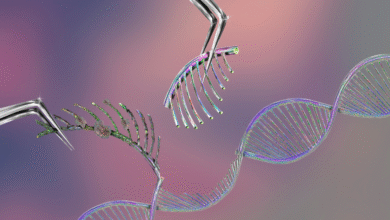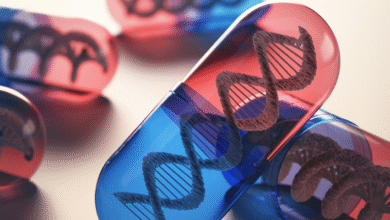What are Genes: A Beginner’s Guide to Genetics

Question: What is the relationship between cells, chromosomes, DNA, and genes?
The relationship between cells, chromosomes, DNA, and genes is hierarchical, meaning they are organized within each other like nested structures. Here’s how they relate:
- Cells: Cells are the basic building blocks of all living organisms. They are the smallest units of life that can function independently. Think of them as the rooms in a house.
- Nucleus (within the cell): Most cells (except for some like red blood cells) have a central control center called the nucleus. This is like the main office or library within the house.
- Chromosomes (within the nucleus): Inside the nucleus are structures called chromosomes. These are like the organized bookshelves in the library. They are made of tightly coiled DNA. Each chromosome contains a long strand of DNA.
- DNA (within the chromosomes): DNA (deoxyribonucleic acid) is the molecule that carries genetic information. It’s like the instruction manuals or cookbooks on the bookshelves (chromosomes). DNA is structured as a double helix (like a twisted ladder).
- Genes (within the DNA): Genes are specific segments or sections of DNA. They are like individual recipes within the cookbooks (DNA). Each gene contains the instructions for making a specific protein or carrying out a specific function in the cell.
Analogy:
Think of a library:
- Cell: The library building itself.
- Nucleus: The main office or archive within the library.
- Chromosome: The bookshelves in the archive.
- DNA: The cookbooks on the shelves.
- Gene: A specific recipe within a cookbook.
In short: Cells contain a nucleus. The nucleus contains chromosomes. Chromosomes are made of DNA. Genes are specific segments of DNA.
This hierarchical organization ensures that the genetic information is efficiently stored, organized, and accessed within each cell.
Question: If DNA is like a cookbook, what are the recipes?
(Genes)
- DNA (The Cookbook): Contains all the instructions necessary for building and operating a living organism. It’s the complete collection of genetic information.
- Genes (The Recipes): Specific sections of DNA that contain the instructions for making a particular protein. Each recipe (gene) has a specific purpose, like making a cake (a specific protein) or a sauce (another protein).
Just like a cookbook contains many different recipes for different dishes, DNA contains many different genes that code for different proteins. These proteins are responsible for a wide variety of functions in the body, such as:
- Building and repairing tissues
- Carrying out chemical reactions
- Transporting molecules
- Fighting infections
So, to reiterate:
- DNA: The complete set of instructions (the cookbook).
- Genes: Individual instructions for specific tasks (the recipes).
Question: Where are chromosomes located in a cell?
(In the nucleus)
- The Nucleus: Think of the nucleus as the control center or the “brain” of the cell. It’s a membrane-bound organelle (a specialized structure within the cell) that houses the cell’s genetic material.
- Chromosomes Inside: The chromosomes, which are made of tightly coiled DNA, reside within this nucleus. This location is crucial because it protects the DNA from damage and ensures that it’s properly organized for cell division.
It’s important to note that not all cells have a nucleus. For example, mature red blood cells in mammals lack a nucleus to make more space for carrying oxygen. However, in most cells of plants and animals (called eukaryotic cells), the chromosomes are safely stored within the nucleus.
Question: How many chromosomes do humans typically have in each cell?
(46, or 23 pairs)
Humans typically have 46 chromosomes in each cell, which are organized into 23 pairs.
Here’s why they come in pairs:
- Inheritance: You inherit one set of 23 chromosomes from your mother (in the egg) and one set of 23 chromosomes from your father (in the sperm).
- Homologous Pairs: The two chromosomes in each pair are called homologous chromosomes. They carry genes for the same traits, but they may have different versions of those genes. For example, one chromosome might carry the gene for blue eyes, while the other carries the gene for brown eyes.
The 23rd pair of chromosomes is special because it determines your sex:
- Females: Have two X chromosomes (XX)
- Males: Have one X chromosome and one Y chromosome (XY)
It’s important to note that there are some exceptions to this rule. For example, people with Down syndrome have an extra copy of chromosome 21 (trisomy 21), resulting in a total of 47 chromosomes.
Question: Why is DNA called a “double helix”?
DNA is called a “double helix” because its structure resembles a spiral staircase.
Here’s a more detailed breakdown of the structure:
- Two Strands: DNA is made up of two long strands that are intertwined.
- Sugar-Phosphate Backbone: Each strand has a “backbone” made of alternating sugar (deoxyribose) and phosphate groups. This is like the sides of the staircase.
- Nitrogenous Bases: Connecting the two strands are chemical “rungs” made of nitrogenous bases. There are four types of these bases: adenine (A), thymine (T), guanine (G), and cytosine (C).
- Base Pairing: These bases pair up in a specific way: A always pairs with T, and G always pairs with C. This is like the steps of the staircase.
- Twisted Ladder: The two strands, with their paired bases, twist around each other to form the characteristic spiral shape, or helix. Since there are two strands, it’s called a double helix.
This double helix structure is crucial for DNA’s function:
- Stability: The twisting structure provides stability to the molecule.
- Replication: The two strands can be easily separated for replication (copying) of the DNA.
- Information Storage: The sequence of bases (A, T, G, C) along the DNA strands encodes the genetic information.
So, the “double helix” name perfectly describes the unique and important structure of DNA.
Function and Purpose:
Question: What is the main function of DNA?
(To carry genetic instructions)
- The Blueprint of Life: DNA acts as the blueprint or instruction manual for building and operating an organism. It contains all the information needed for:
- Development: How an organism grows from a single cell to a complex being.
- Function: How the body’s cells, tissues, and organs work.
- Reproduction: Passing genetic information from one generation to the next.
- Encoded in the Sequence: This information is encoded in the sequence of the four nitrogenous bases (A, T, G, C) along the DNA molecule. The specific order of these bases determines the instructions for making proteins.
- Instructions for Proteins: Genes, which are specific segments of DNA, contain the instructions for building proteins. Proteins are the workhorses of the cell, carrying out a wide range of functions.
In essence, DNA stores the genetic information, and this information is used to create proteins that determine an organism’s traits and functions.
Question: What do genes do?
(They provide instructions for making proteins, which carry out various functions in the body)
- DNA to RNA to Protein: The information flow goes like this: DNA → RNA → Protein. This is often referred to as the “central dogma of molecular biology.”
- Transcription (DNA to RNA): The gene’s DNA sequence is copied into a molecule called RNA (ribonucleic acid). This is like copying a recipe from the cookbook onto a notecard.
- Translation (RNA to Protein): The RNA molecule then serves as a template for building a protein. This is like following the instructions on the notecard to actually bake the cake.
- Proteins: The Workhorses of the Cell: Proteins are large, complex molecules that perform a wide variety of functions in the body, including:
- Structural proteins: Provide support and structure to cells and tissues (e.g., collagen in skin, keratin in hair).
- Enzymes: Speed up chemical reactions in the body (e.g., digestive enzymes).
- Hormones: Act as chemical messengers, coordinating communication between different parts of the body (e.g., insulin).
- Transport proteins: Carry molecules throughout the body (e.g., hemoglobin carries oxygen in the blood).
- Antibodies: Help fight infections.
- Genes Determine Traits: Because genes provide the instructions for making proteins, they ultimately determine an individual’s traits, such as eye color, hair color, height, and even predisposition to certain diseases.
Question: Why are proteins important?
(They are the building blocks and workhorses of the body, responsible for many functions)
1. Building Blocks (Structural Role):
- Tissues and Organs: Proteins provide structure and support to cells, tissues, and organs. For example:
- Collagen: A protein that provides strength and elasticity to skin, bones, tendons, and ligaments.
- Keratin: A protein that forms hair, nails, and skin.
- Muscle fibers: Made of proteins like actin and myosin, which are responsible for muscle contraction.
2. Workhorses (Functional Role):
Proteins perform a vast array of functions in the body:
- Enzymes: These proteins catalyze (speed up) biochemical reactions, such as:
- Digesting food
- Replicating DNA
- Generating energy
- Hormones: These proteins act as chemical messengers, coordinating communication between different parts of the body. Examples include:
- Insulin (regulates blood sugar)
- Growth hormone (promotes growth and development)
- Transport Proteins: These proteins carry molecules throughout the body:
- Hemoglobin (carries oxygen in red blood cells)
- Lipoproteins (transport fats and cholesterol in the blood)
- Immune System Proteins (Antibodies): These proteins help fight infections by recognizing and neutralizing foreign invaders like bacteria and viruses.
- Contractile Proteins: These proteins are responsible for muscle contraction and movement.
- Storage Proteins: These proteins store essential substances, such as:
- Ferritin (stores iron)
Question: How do genes determine our traits?
(By providing instructions for making proteins that influence our characteristics)
- Genes as Instruction Manuals: Each gene contains a specific sequence of DNA that acts as a blueprint or instruction manual for building a particular protein.
- Protein Synthesis: This blueprint is used in a two-step process called protein synthesis:
- Transcription: The DNA sequence of a gene is copied into a messenger molecule called RNA (mRNA).
- Translation: The mRNA molecule is then used as a template to assemble amino acids into a specific protein.
- Proteins and Traits: Proteins perform a vast array of functions in the body, and these functions directly influence our traits. Here are some examples:
- Eye color: Proteins determine the amount and type of pigment (melanin) in the iris of the eye. Different versions of the genes involved in melanin production result in different eye colors (e.g., brown, blue, green).
- Height: Multiple genes are involved in determining height. These genes code for proteins that regulate growth, bone development, and other factors that contribute to overall height.
- Hair color and texture: Proteins determine the type and amount of pigment in hair, as well as the structure of the hair follicle, which affects hair texture (e.g., straight, curly, wavy).
- Blood type: Proteins on the surface of red blood cells determine blood type (A, B, AB, O).
- Disease predisposition: Some genes can increase or decrease an individual’s risk of developing certain diseases, such as heart disease, diabetes, or cancer. These genes often code for proteins involved in processes related to those diseases.
- Influence of Multiple Genes and Environment: It’s important to note that many traits are influenced by multiple genes (polygenic traits) and also by environmental factors. For example, height is influenced by genes related to growth and bone development, but also by nutrition and overall health during childhood.





